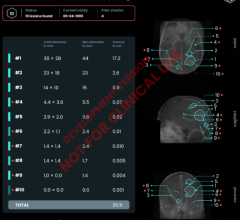December 28, 2012 — Elekta announced it has received 510(k) clearance from the U.S. Food and Drug Administration (FDA) for its Clarity 4-D Monitoring software, enabling U.S. medical centers to implement this new way of reducing the uncertainty caused by prostate motion during radiation treatment. Physicians will be able to monitor the motion of the prostate and surrounding tissues and organs – in real-time and with sub-millimeter accuracy – during the delivery of therapeutic radiation beams.
The ability to continuously visualize the prostate’s precise location constantly during treatment is especially important for clinicians pursuing advanced prostate protocols, such as reduced margin hypofractionated therapy or advanced stereotactic ablative body radiotherapy (SABR).
“What makes 4-D monitoring with Clarity a possible ‘game-changer’ is that it’s simple, inexpensive and will enable real-time continuous monitoring of the prostate – increasingly critical as we consider techniques such as hypofractionation, which entails treating patients in shorter therapy courses, but with longer individual treatments,” said James Wallace, M.D., radiation oncologist at Fletcher Allen Health Care, Burlington, Vt. “We know that the prostate moves during these prolonged treatments and we are going to have to account for it in some way. The capability to observe the prostate from the beginning of the fraction to the end will be incredibly powerful. We will integrate 4-D monitoring with Clarity into our clinical practice as soon as we can.”
Wallace also observed the image quality of Clarity ultrasound. “It’s remarkably clear compared to other ultrasound technology, and in our experience comparable to MRI [magnetic resonance imaging] in terms of our ability to identify structures in the lower pelvis,” he noted. “In comparison to other systems, 4-D monitoring with Clarity will not only be more cost-efficient, but patient acceptance will also be higher. Telling patients that we have a new way to track their prostate without sticking a needle through the rectum will make them pretty happy.”
The capability to image anatomy during treatment could provide other advantages as well, according to Di Yan, DSc, chief physicist at William Beaumont Hospital in Royal Oak, Mich. "We have been interested in developing methods for adaptive therapy for a while now,” he said. “The missing link has been the anatomical information from a continuous imaging source. Clarity 4-D Monitoring with an Autoscan probe has great potential to provide that missing link.”
Continuous target visualization
Clarity 4-D monitoring of the prostate during treatment offers continuous tracking of the target and imaging of the surrounding anatomy, including the bladder, rectum and penile bulb, the latter thought to be responsible for erectile function. Clearly visualizing these structures during treatment could enable clinicians to create plans with tighter margins around intended targets, thereby minimizing radiation exposure to healthy tissue.
Clarity 4-D monitoring uses Autoscan acquisition technology, which robotically acquires live transperineal ultrasound images of soft tissue anatomy from the linear accelerator control area. This is a noninvasive imaging procedure that does not involve any extra radiation dose and does not require the use of implanted markers.
For more information: www.elekta.com/clarity


 December 11, 2025
December 11, 2025 









